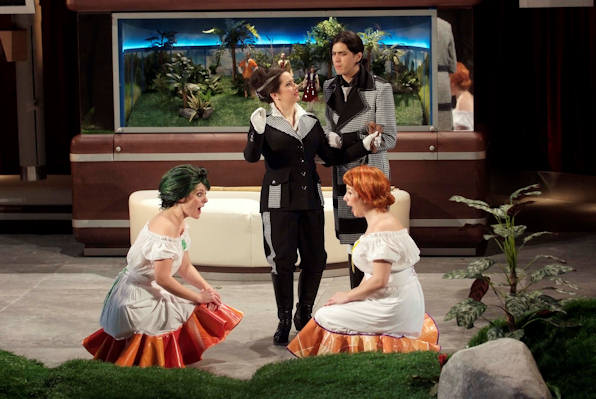Other Links
Editorial Board
-
Editor - Bill Kenny
Assistant Webmaster - Stan Metzger - Founder - Len Mullenger
Google Site Search
SEEN AND HEARD INTERNATIONAL OPERA REVIEW
V. Martín i Soler, Una Cosa Rara:
Soloists, Orquestra de la Comunitat Valenciana. Cor de la Generalitat Valenciana. Conductor: Sergio Alapont. Teatro Martín i Soler de Valencia (Palau de les Arts). 21.2.2010. (JMI)
Isabella: Ofelia Sala.
Giovanni: Joel Prieto.
Lilla: María Hinojosa.
Guita: Maite Alberola.
Lubino: Isaac Galán.
Tita: Lluis Martínez-Agudo.
Corrado: Javier Tomé.
Lisargo: Savio Sperandio.
New Production.
Director: Francisco Negrín.
Sets: Rifail Ajdarpasic and Ariane Isabell Unfried.
Costumes: Louis Desiré.
Lighting: Bruno Poet.

Production Picture © Tato Baeza
Valencia’s Palau de les Arts continues its policy of mounting performances of the work of Vicente Martín y Soler.
Soler’s Una Cosa Rara, ossia Beauty and Honesty is his most celebrated work if not necessarily a masterpiece. All opera-lovers are in any event likely to remember the fragment of Soler’s music that the small orchestra plays on stage during Don Giovanni’s last scene and Leporello’s expression. "Bravi, Cosa Rara!". Taking into account the short time elapsed between the premieres of the Soler and the Mozart, there is little doubt that Una Cosa Rara became very popular at the end of the 18th century. In recent years however there have been very few performances. I can remember only a couple of productions in Germany and also at Santa Fe’s Opera Festival.
As with L'Arbore di Diana, Una Cosa Rara sports a libretto by Lorenzo da Ponte - one of the best librettists in the history of opera. On this occasion the libretto is fresh and sparkling, although not quite as much as in L’Arbore de Diana, which is magnificent. The plot treats of the beauty and honesty (Cosa rara or Strange thing) of the young girl Lilla, who loves Lubino. Her brother Tita has promised her to one Major Lisargo. Tita is also in love and is promised to Ghiţa, Lisargo’s sister. Queen Isabella arrives with a hunting party, accompanied by Prince Giovanni and his valet Corrado. They fall in love unable to resist the beauty of Lilla, who only has eyes for her lover Lubino. She rejects the proposals of the noble knights. The misunderstandings are constant and spring tirelessly from the simple and jealous behaviour of the villagers, Lubino and Tita. Things come to a happy end with the intervention of the Queen. She punishes Corrado and grants the wedding of both couples. The opera finishes with a party for the Queen replete with singing and seguidillas.
Soler’s opera is a classic opera buffa, with some beautiful arias, especially for the Queen and the two young girls. The famous passage that appears in Don Giovanni can be heard in the ensemble music that brings the first act to a close. The writing becomes more lively during the second half of the opera. In fact the first act can be a little monotonous.
The new production by Francisco Negrín is clearly designed for this small theatre-auditorium. The stage is in two levels, initially showing a green field with trees. When the lower level opens we can see the apartments of the Queen and her entourage. The action is lightly modernised with frivolously colourful costumes. The sets are simple, but effective enhanced by good lighting. Mr Negrin is also strong on stage direction – all the more important since the artists are mostly young singers.
This performance was the last of the run. Musical direction was in the hands of the young Valencian Sergio Alapont; Ottavio Dantone had to make tracks to attend rehearsals of L’Arbore di Diana at Teatro Real. I missed Mr. Dantone, especially in the first half of the opera. The reading by Sergio Alapont was rather square and routine during Act I – rather at odds with the sparkling style of this music. Things improved in the second half, where there was more lightness in his conducting. He had in the pit the usual excellent orchestra.
The cast offered two well known singers, as Queen and Prince. The rest were interpreted by a young contingent from el Centro de Perfeccionamiento Plácido Domingo at Palau de les Arts.
Isabella, the Catholic Queen, was performed by Valencian soprano Ofelia Sala. She was good, but her voice is rather small and its projection suffers when singing at the top of the stage. Something similar happens with Puerto Rican tenor Joel Prieto, Prince Giovanni. He has a pleasant voice, small in volume and with consequent difficulties in reaching the audience.
The real protagonist is Lilla, who was played by soprano Maria Hinojosa, who offered an outstanding performance. Her voice is a light-lyric soprano, singing very well. She makes a delightful impression with her attractive figure and good acting skills. Her biggest problem is that the high notes are somewhat acid, especially when singing at full voice. She shows sanguine promise for the future.
Valencian soprano Maite Alberola gave life to Ghiţa. She has an outstandingly engaging lyric soprano voice coupled with communicative engagement with her characters.
The rest of the cast, all men, were not at the same level. Baritone Isaac Galán was good in the part of Lubino, with lyric strengths even if he still has work to do. Lluis Martínez-Agudo has a pleasant sound, but his remains a voice in waiting. Javier Tome was competent as Corrado, although the voice is flawed. Savio Sperandio was the weakest in the cast as Lisargo.
The theatre was almost sold out. At the final bows the three ladies attracted the biggest applause.
José M Irurzun
